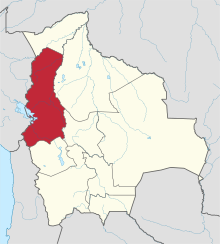
The La Paz Department in Bolivia
The La Paz Department lies in the northwest Bolivia. In it are the seat of government of Bolivia, La Paz, and its surroundings as well as the east of the Lake Titicaca.
Regions
&groups=Maske,Track,Aktivitaet,Anderes,Anreise,Ausgehen,Aussicht,Besiedelt,Fehler,Gebiet,Kaufen,Kueche,Sehenswert,Unterkunft,aquamarinblau,cosmos,gold,hellgruen,orange,pflaumenblau,rot,silber,violett)
Map of La Paz (Departamento)
The region is divided into two very different geographic regions:
- Altiplano in the south, with the capital La Paz, a barren plateau
- Yungas in the north, a transition region between the plateau and the Amazon rainforest
places
- 1 La Paz
 , Seat of government of Bolivia, 800,000 residents
, Seat of government of Bolivia, 800,000 residents - 2 El Alto, independent suburb of La Paz on the plateau, 700,000 inhabitants
- 3 Copacabana, 10,000 inhabitants, capital of the Lake Titicaca region
- 4 Achacachi on Lake Titicaca, 10,000 inhabitants
- 5 Coroico, most important city of the Yungas
Other goals
- Isla del Sol (Sun Island) in Lake Titicaca
- Isla de la Luna (Moon Island) in Lake Titicaca
background
With 2.5 million inhabitants, the La Paz department is the most populous in Bolivia. With La Paz itself, Lake Titicaca and Tihuanaco, the most important travel destinations are also in the region.
language
getting there

LagunaChiarKhota
mobility
Tourist Attractions
- Tihuanaco. Most important archaeological site in Bolivia.
activities
kitchen
Chairo (soup)
nightlife
security
climate
The climate in the Altiplano at an altitude of 3,000 to 4,000 m is cool (15 ° -20 ° C during the day all year round) with cold nights and frequent frosts. In winter it is sunny and dry, but in summer it is often rainy. In the approximately 1000 m high Yungas, the climate is much milder.





